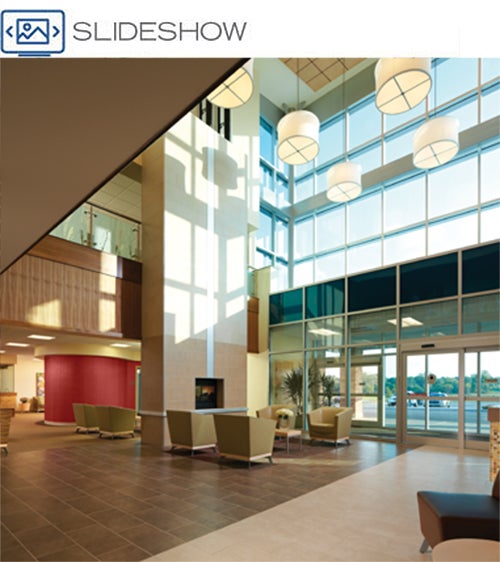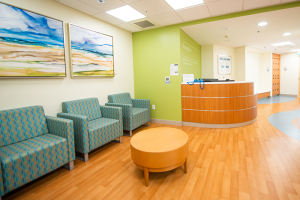Health care design for boomers and beyond
As more boomers enter the senior generation, the planning and design community continues to seek ways to design health care and wellness facilities for this significant cohort. This is challenging because there is no clear definition of this cohort’s needs and desires with regard to the health care built environment.
To complicate this challenge further, there is no consistent definition of this largest-growing segment of the U.S. population — those 65 and older. There is no standard term to describe this generation, variously referred to as boomer, aged, elderly, active elderly, senior, senior citizen and geriatric.
Also in this article |
| Generational cohorts in hospital design |
|
As the design industry has matured with the incredible information and data available to planning and design professionals over the past decade, there has been a realization that designing to meet current codes and guidelines is not enough. Universal design is a new design approach that is evolving within the profession.
Universal design provides new and comprehensive design criteria, applicable to the boomer generation as well as all users of the built environment, including the aged, elderly, handicapped and bariatric patients, as well as persons with special needs.
Built environment elements
Physical and sensory elements that are specific challenges to boomers in their interaction with health care and wellness environments include patient rooms, sleeping rooms, emergency departments and building-entry sequence as well as such sensory factors as falling hazards, hearing issues, lighting, sight issues, tactile issues and habitual tendencies. Some of these elements include:
You may also like |
| Boomers put new demands on design |
| Designing spaces for multiple generations |
| Meeting the needs of an aging generation |
|
Site access and building entrances. There is a minefield of potential problems associated with these highly utilized areas. Traditionally, many reported injuries are associated with the site and entrances. This is due to a variety of reasons, but the general theme typically involves the disorientation of the patient, family member or visitor. They are in a different environment and do not know where to go, which causes disorientation and possible injury.
Universal design principles are applicable and critically important when factoring in increased numbers of boomers and those requiring special design accommodation.
The exterior site-entry sequence begins on the street when approaching health and wellness facilities. In particular, boomers and those with limited peripheral vision benefit from straightforward and easily visible locations of canopies and building entrances.
Once the visitor has parked, it is important for visitors to understand the most direct path to the desired canopy and building entrance. The most identifiable and direct path of travel usually is the safest and most appropriate.
An important universal design principle is to ensure that there are no areas of blind or obstructed views, or specific situations that are potentially dangerous. Boomers and those with physical challenges may require additional concentration and effort to walk from their parking spaces to the canopy and building entrance.
Wayfinding through primary public corridors. As boomers are exposed to more off-campus centers, they realize the ease and comfort of navigating in these settings. So when they need to utilize the hospital or medical center, they expect a similar wayfinding experience.
This is easier said than done when dealing with a maze of parking areas and buildings constructed over many decades. However, there are basic universal design principles that may create a successful wayfinding experience for boomers and other patients with challenges.
For those who are older and with less dexterity, confidence and balance, entry vestibule designs require careful consideration. The travel path through the vestibule must be intuitive and lead to a “pause-and-view” area, which should be out of the travel path and easy to identify. It also should provide intuitive cues as to where the visitor is and where he or she needs to go, and encourage them to begin walking in the desired direction.
Once through the entry vestibule and into the building, intuitive wayfinding is critically important for all users and occupants. However, intuitive wayfinding is even more important for boomers and the elderly because of the thousands of wayfinding interactions they’ve had in their lifetimes. These cues include natural light, highlighted artificial lighting, artwork galleries, widened corridors, higher ceilings and related features.
The next series of sequential wayfinding cues are usually the most difficult to achieve in larger buildings such as health care facilities. This is because they include making turns from corridor to corridor and other types of intersection interactions. The most important and effective design element includes a clear and intentional feature or highlight within the intersection or at the corridor turn. In addition, other important design and universal design factors help challenged individuals travel in public corridors.
The introduction of natural light to public corridors and adjacent waiting rooms provides intuitive wayfinding. Designated reorientation areas also can be created with the widening of corridors and features at appropriate locations. Designers also can utilize the change of ceiling heights, feature lighting and wall changes at important intersections and nodes.
Wayfinding maps should be oriented in the exact direction that the person is viewing. Additionally, wayfinding signs should not include too much information that may confuse readers. Letter sizes and fonts on signage should be legible to the visually challenged. All wayfinding terms, arrows and information on directional signage should be simplified.
Patient rooms and residential rooms. The boomer generation and related groups now are experiencing two different sleeping rooms. On one hand, there will be a need for hospitalization for more acute conditions that require intensive or critical care types of patient rooms. On the other hand, the boomer generation is leading the charge for a significant number of residential rooms. Each type of sleeping room requires more design attention to meet the needs of this patient demographic and to provide universal design for all.
The health care design community understands that there are numerous opportunities to improve patient room design in terms of comfort and functionality. Most of these are considered universal design principles and go beyond the basic code and guideline requirements. They represent commonsense actions and observations that architects and interior designers have learned throughout their careers. They include:
- Adding clearances where caregivers can move about and gather in the room;
- Accommodating patient use of computer devices while hospitalized or in ambulatory settings;
- Accommodating the use of earbuds or headphones by making connections available;
- Eliminating lighting that shines ldirectly in the eyes of the patient or outpatient;
- Carefully considering the type of lighting that is utilized at night.
- Improving patient comfort and bedside activities while resting and relaxing in both inpatient and outpatient settings.
There is an increase in the number of residential rooms being developed and operated in many different building types and related living units. Examples include independent living, assisted living, rehab unit, dementia units, senior center, group living and nursing homes. With less stringent facility regulatory requirements, universal design principles are important to integrate in the planning and design of the residential room. They include:
- Adding features available in hotels and apartments over the past decade;
- Providing for a variety of family and friend settings in the residential room:
- Considering the location of all fixed elements due to boomers' limited movement and flexibility;
- Providing additional clearances around furnishings, doors and hallways.
Exam, treatment and diagnostic rooms. With the increased utilization of treatment rooms within hospitals, outpatient care facilities, clinics and physician offices, it is important to improve their functionality.
Due to the decline in the utilization of inpatient services, the connection between the caregiver and the boomer generation is more prevalent in these spaces. In addition, with increased telemedicine services, treatment rooms may require design improvements.
In all instances, there is communication among the patient, family members and caregivers. This involves one or multiple computer screens and it is important to design for this specific interaction. For those with declined sight and mobility, the place for this discussion and viewing of screens must be functional and provide patient and family satisfaction.
The design of this patient-to-caregiver interaction involves many design and construction disciplines to achieve a human-centered solution. In addition, the interaction with equipment, technology and information systems is critical.
There are specific scenarios and issues related to creating appropriate universal design solutions. They include:
- Caregiver discussions with patients and family members;
- Caregivers sharing medical information and data via computers, monitors and devices;
- Face-to-face communication and connection;
- Consultation and medical exam through utilization of telemedicine services and telephone conferences;
- Medical exams on tables or seats;
- Vitals reviews and discussions while the patient is seated in a chair;
- Waiting areas before the exam or procedure and afterward.
There are many exam, treatment or diagnostic rooms that have not been upgraded or renovated within the past 10 years. In almost all instances, technology and computerization have been upgraded or replaced without consideration for the needs of the boomer generation and provisions for universal design.
Tactile and sensory elements
Sensory and physical examples include elements that are challenges to boomers in their interactions with health care and wellness environments. Examples include falling hazards, hearing issues, sight issues, tactile and habitual tendencies. Moreover, any occupant or user regardless of age, gender or specific handicap can experience these problems if proper considerations are not taken during the design process.
Surface materials. One of the significant risks within health care facilities involves the tripping and falling of patients, visitors and team members. Given the increasing numbers of boomers, older persons and physically challenged who utilize these facilities, it is critically important to address these risks.
This issue is complicated because of the need to provide a less institutional environment. A built environment designed for health, wellness and healing includes some of those same elements that cause the problems. On the other hand, the manufacturers of interior materials and products have made great strides in creating building products that deter tripping and falling in health care facilities. Some considerations include:
- Carefully assessing floor material or color changes in primary corridors with patient safety placed above aesthetic design goals and objectives.
- Minimizing or eliminating minor changes in floor level and other potential floor hazards due to thresholds, expansion joints and plumbing cleanout covers.
- Eliminating floor materials that are slippery during many scenarios. For instance, include nonskid floor materials in key areas where water and moisture are present during specific situations. Also, include slip-free floor materials throughout primary corridors to provide a safe environment for all occupants and users of facilities.
- Using recessed floor mats to avoid the placement of throw mats throughout primary public corridors.
Colors and patterns. In many instances, tripping and falling results from a person’s disorientation. Research has proven that patients, visitors and staff 60 and older have declined vision based on a number of factors.
This requires new approaches to the interior design of the walls along primary corridors, to prevent overstimulation and confusion among occupants and users of health care facilities. This is important because colors along walls are viewed peripherally, which is not as clear for boomers because their eyesight clarity diminishes.
Confusion often is caused by specific colors, textures and patterns on floors and walls. With age, eyes change and have difficulty discerning colors and depth perception. In addition, the inclusion of texture and patterns causes confusion and disorientation among boomers.
Boomers can be overstimulated by excessive materials and products, including textures and patterns on the walls and floors of public areas and corridors, as well as elements added to furniture and furnishings.
As the occupants and users of health care facilities age, it is important to utilize universal design principles and respond appropriately with the comprehensive products and materials of interior design.
Meeting the needs
With the wave of the boomer generation reaching age 65, there is a new building occupant and user that must be accommodated. This large cohort undoubtedly will continue to utilize multiple health care building typologies over the next decades.
As a result, the planning and design community should be challenged to stretch and exceed the required codes and guidelines. This constitutes universal design principles and has the added benefit of meeting the needs of all users and occupants regardless of age or physical health.
Gary L. Vance, FAIA, FACHA, LEED AP, is president of Vance Consulting LLC, Carmel, Ind. He can be reached at gvancefaia@gmail.com.





